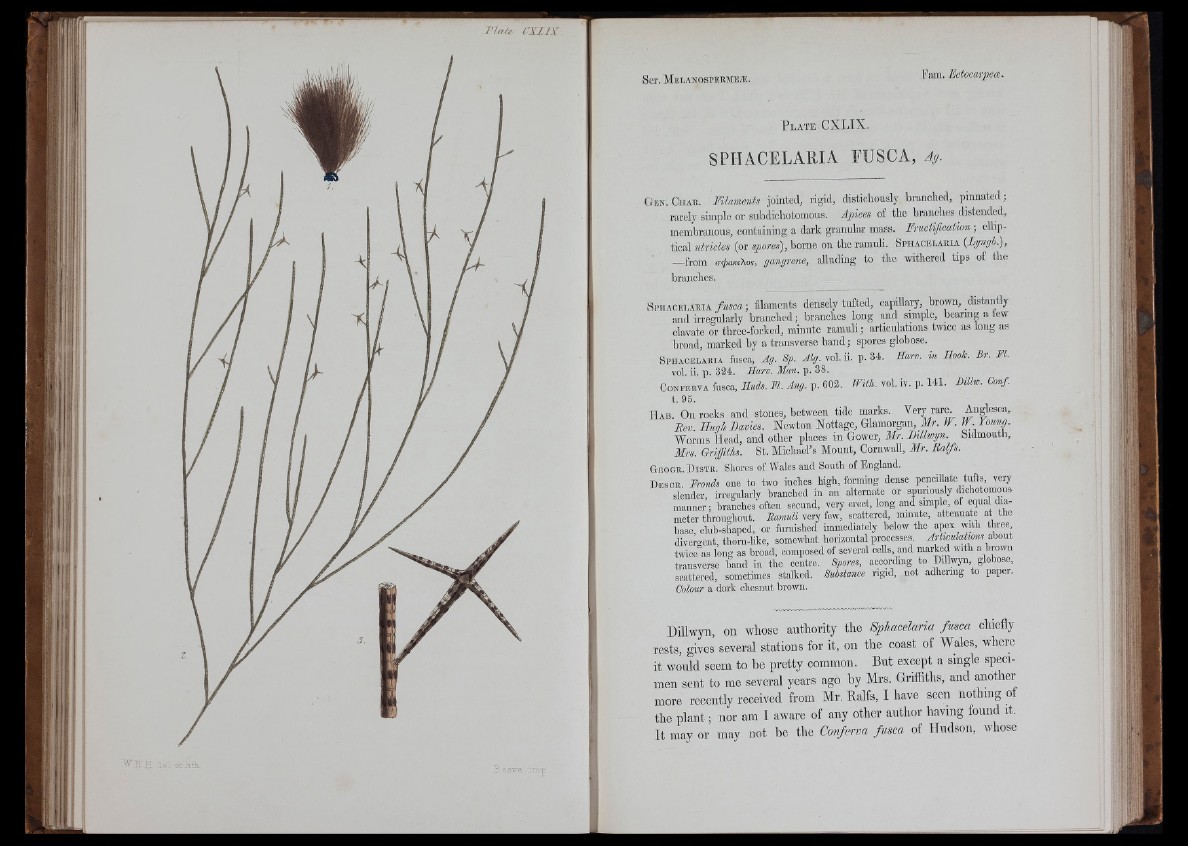
ii!
_;;.D
P l a t e CXLIX.
SPHACELARIA FUSCA, Ag.
(iiM.CiiAE. Filaments jointed, rigid, disticliously branched, pinnated;
rarely simple or subdicliotomous. Apices of the branches distended,
membranous, ooutaining a dark granular mass. Fructification ; ellij)-
tical utricles (or spores), borne on the ramuli. S p h a c e l a u i a [lynffl).),
— from afiaKiXos, gangrene, alluding to the withered tips of th e
branches.
S ph a o b la iu a / « s c« ; filaments densely tu fte d , capillary, broTO, d is ta n tiy
an d irrcg'ularly b ra n c h e d ; b ran c h e s lo n g an d simple, b c a n n p few
clavate or th re e -fo rk ed , m in u te r am u li; a rtic u la tio n s twice as lo n g as
bro ad , m a rk ed by a tran sv e rse b a n d ; spores globose.
S pha ce lama fusca, Ag. Sp. Alg. vol. ii. p. 34. Ilarv. in Iloolc. Br. FI.
vol. ii. p. 324. Harv. Man. p. 38.
CoNEEEVA fusca, Huds. M. Ang. p. 602. With. vol. iv. p. 141. Billw. Conf.
t. 95.
IIa b . On rocks and stones, between tide marks. Very rare. Anglesea,
Rev. Hugh Davies. Newton Nottage, GXamatpn M r. W. W-Younp.
Worms Head, and other places in Gower, M r. Dillwyn. bidmoutli,
Mrs. Oriffiths. St. MieliaeFs Mount, Cornwall, M r. B a lfs.
G eogk. D istk . Shores of Wales and South of England.
D esck. Fronds one to two inches high, forming dense pencillate tufts, very
slender, irregularly branched in an alternate or spuriously dichotomous
manner; branches'often secund, very erect, long and simple of equal diameter
throughout. Ramuli very few, scattered, minute, attenuate a t th e
base, club-shaped, or furnished immediately below the apex wftli three
divergent, thorn-like, somewhat horizontal processes. A rhmM w n s ahont
twice as long as broad, composed of several cells, and marked with a brown
transverse band in the centre. Spores, according to Dillwyn globose,
scattered, sometimes stalked, Substance rigid, not adhering to paper.
Colour a dark cUesmit brown.
f t'l
I",!]
Dillwyn, on whose authority the Sphacelaria fusca chiefly
rests, gives several stations for it, on the coast of Wales, where
it would seem to be piretty common. But except a single specimen
sent to me several years ago by Mrs. Griffiths, and another
more recently received from Mr. Balfs, I have seen nothing of
the plant; nor am I aware of any other author having found it.
It may or may not be tbe Conferva fusca of Hudson, whose